Numerical Simulation of Electrical Properties for Pore-Scale Hydrate-Bearing Sediments with Different Occurrence Patterns and Distribution Morphologies
Abstract
1. Introduction
2. Method
2.1. The Occurrence Patterns of Hydrates at the Microscopic Scale
2.2. Microscopic Numerical Simulation Methods
2.3. Simulation of Saturation Model
3. Numerical Simulation of Electrical Properties at the Microscopic Pore Scale
3.1. Porous Medium Model
3.2. Setting of the Numerical Simulation Model
4. Results
4.1. Three Occurrence Patterns of Hydrates in Sediments
4.2. Five Distribution Morphologies of Hydrates in the PF Mode
4.3. Saturation Exponent n in the Archie Formula
4.4. Analyses of Influencing Factors
5. Discussion and Limitations
6. Conclusions
- (1)
- The changes in resistivity can be roughly divided into three stages for multiple occurrence patterns and distribution morphologies. In the first stage, when the hydrate saturation was below 0.2, the effect on electrical conduction was almost negligible. In the second stage, resistivity grew slowly in the range of a hydrate saturation of 0.2~0.4. Finally, resistivity increased rapidly with hydrate saturation when the hydrate saturation reached above 0.5.
- (2)
- For the LB mode, resistivity was relatively high even when the hydrate saturation was low, which is quite different from the other two modes. The resistivity of different distribution morphologies of hydrate in the PF mode varied greatly with hydrate saturation, and even with the same hydrate distribution morphology, the resistivity changes in the two models were not completely the same.
- (3)
- The saturation exponent n, which was obtained by the fitting relationship between the resistivity index and water saturation, varied widely for different distribution morphologies of the PF mode. After a comparison with previous work, it is suggested that for sediments with a high hydrate saturation (Sh > 0.4), the saturation exponent n can be taken as 2.42 ± 0.2.
- (4)
- The skeleton grain arrangement of the sediment, initial porosity, hydrate saturation, conductivity of seawater, tortuosity, pore and throat size all complicate the conductive mechanism of electric current, which in turn affects the electrical properties of hydrate-bearing sediments, with the size of the throat being the most critical factor affecting resistivity.
Author Contributions
Funding
Institutional Review Board Statement
Informed Consent Statement
Data Availability Statement
Conflicts of Interest
References
- Sloan, E.D., Jr. Fundamental principles and applications of natural gas hydrates. Nature 2003, 426, 353–363. [Google Scholar] [CrossRef] [PubMed]
- Sloan, E.D., Jr.; Koh, C.A. Clathrate Hydrates of Natural Gases; CRC Press: Boca Raton, FL, USA, 2007. [Google Scholar]
- Kvenvolden, K.A.; Lorenson, T.D. The Global Occurrence of Natural Gas Hydrate. Nat. Gas Hydrates Occur. Distrib. Detect. 2001, 124, 3–18. [Google Scholar] [CrossRef]
- Stern, L.A.; Kirby, S.H.; Durham, W.B. Peculiarities of Methane Clathrate Hydrate Formation and Solid-State Deformation, Including Possible Superheating of Water Ice. Science 1996, 273, 1843–1848. [Google Scholar] [CrossRef]
- Stanwix, P.L.; Rathnayake, N.M.; De Obanos, F.P.; Johns, M.L.; Aman, Z.M.; May, E.F. Characterising thermally controlled CH4–CO2 hydrate exchange in un-consolidated sediments. Energy Environ. Sci. 2018, 11, 1828–1840. [Google Scholar] [CrossRef]
- Metaxas, P.J.; Lim, V.W.; Booth, C.; Zhen, J.; Stanwix, P.L.; Johns, M.L.; Aman, Z.; Haandrikman, G.; Crosby, D.; May, E.F. Gas hydrate formation probability distributions: Induction times, rates of nucleation and growth. Fuel 2019, 252, 448–457. [Google Scholar] [CrossRef]
- Atig, D.; Broseta, D.; Pereira, J.-M.; Brown, R. Contactless probing of polycrystalline methane hydrate at pore scale suggests weaker tensile properties than thought. Nat. Commun. 2020, 11, 3379–3387. [Google Scholar] [CrossRef]
- Koh, C.A.; Sloan, E.D. Natural gas hydrates: Recent advances and challenges in energy and environmental applications. AIChE J. 2007, 53, 1636–1643. [Google Scholar] [CrossRef]
- Ruppel, C.D.; Kessler, J.D. The interaction of climate change and methane hydrates. Rev. Geophys. 2017, 55, 126–168. [Google Scholar] [CrossRef]
- Lei, L.; Hu, G.W. Marine gas hydrate: Geological characterization, resource potential, exploration, and development. J. Mar. Sci. Eng. 2023, 11, 322. [Google Scholar] [CrossRef]
- Hyndman, R.; Yuan, T.; Moran, K. The concentration of deep sea gas hydrates from downhole electrical resistivity logs and laboratory data. Earth Planet. Sci. Lett. 1999, 172, 167–177. [Google Scholar] [CrossRef]
- Ming, D.; Wenbo, W.; Wenbo, Z.; Yan, S.; Yanjun, L.; Meng, W. Electric field responses of different gas hydrate models excited by a horizontal electric dipole source with changing arrangements. Pet. Explor. Dev. 2010, 37, 438–442. [Google Scholar] [CrossRef]
- Chen, Y.F.; Li, D.L.; Liang, D.Q.; Du, J.W.; Wu, N.Y. Resistivity measurement on the marine containing natural hydrate. Prog. Geophys. 2013, 28, 1041–1047. [Google Scholar]
- Waite, W.F.; Santamarina, J.C.; Cortes, D.D.; Dugan, B.; Espinoza, D.N.; Germaine, J.; Jang, J.; Jung, J.W.; Kneafsey, T.J.; Shin, H.; et al. Physical properties of hydrate-bearing sediments. Rev. Geophys. 2009, 47, 465–484. [Google Scholar] [CrossRef]
- Konno, Y.; Jin, Y.; Yoneda, J.; Kida, M.; Egawa, K.; Ito, T.; Suzuki, K.; Nagao, J. Effect of methane hydrate morphology on compressional wave velocity of sandy sediments: Analysis of pressure cores obtained in the Eastern Nankai Trough. Mar. Pet. Geol. 2015, 66, 425–433. [Google Scholar] [CrossRef]
- Liu, H.; Guo, P.; Zhan, S.; Ma, P.; Wei, N.; Zhao, J.; Qiu, Y. Experimental investigation into formation/dissociation characteristics of methane hydrate in consolidated sediments with resistance measurement. Fuel 2018, 234, 985–995. [Google Scholar] [CrossRef]
- Du Frane, W.L.; Stern, L.A.; Constable, S.; Weitemeyer, K.A.; Smith, M.M.; Roberts, J.J. Electrical properties of methane hydrate + sediment mixtures. J. Geophys. Res. Solid Earth 2015, 120, 4773–4783. [Google Scholar] [CrossRef]
- Lu, R.; Stern, L.A.; Du Frane, W.L.; Pinkston, J.C.; Roberts, J.J.; Constable, S. The Effect of Brine on the Electrical Properties of Methane Hydrate. J. Geophys. Res. Solid Earth 2019, 124, 10877–10892. [Google Scholar] [CrossRef]
- Spangenbe, E.; Kulenkampff, J. Influence of methane hydrate content on electrical sediment properties. Geophys. Res. Lett. 2006, 34, L24315. [Google Scholar] [CrossRef]
- Li, F.-G.; Sun, C.-Y.; Li, S.-L.; Chen, G.-J.; Guo, X.-Q.; Yang, L.-Y.; Pan, H.; Li, S.; Zhang, K. Experimental Studies on the Evolvement of Electrical Resistivity during Methane Hydrate Formation in Sediments. Energy Fuels 2012, 26, 6210–6217. [Google Scholar] [CrossRef]
- Chen, X.; Espinoza, D.N.; Luo, J.S.; Tisato, N.; Flemings, P.B. Pore-scale evidence of ion exclusion during methane hydrate growth and evolution of hydrate pore-habit in sandy sediments. Mar. Pet. Geol. 2020, 117, 104340. [Google Scholar] [CrossRef]
- Lee, M.W.; Collett, T.S. A Method of Shaly Sand Correction for Estimating Gas Hydrate Saturations Using Downhole Electrical Resistivity Log Data; Scientific Investigations Report; Geological Survey, U.S.: Washington, DC, USA, 2006; p. 5121.
- Zhu, L.-Q.; Sun, J.; Zhou, X.-Q.; Li, Q.-P.; Fan, Q.; Wu, S.-L.; Wu, S.-G. Well logging evaluation of fine-grained hydrate-bearing sediment reservoirs: Considering the effect of clay content. Pet. Sci. 2023, 20, 879–892. [Google Scholar] [CrossRef]
- Dong, H.; Sun, J.; Lin, Z.; Fang, H.; Li, Y.; Cui, L.; Yan, W. 3D pore-type digital rock modeling of natural gas hydrate for permafrost and numerical simulation of electrical properties. J. Geophys. Eng. 2017, 15, 275–285. [Google Scholar] [CrossRef]
- Yang, H.; Xue, X.; Chen, X.; Xie, J.; Zheng, Q. A Study on the Electrical Characteristics of Fractured Gas Hydrate Reservoirs Based on Digital Rock Technology. Lithosphere 2021, 2021, 1365284. [Google Scholar] [CrossRef]
- Zhao, J.; Liu, C.; Li, C.; Zhang, Y.; Bu, Q.; Wu, N.; Liu, Y.; Chen, Q. Pore-Scale Investigation of the Electrical Property and Saturation Exponent of Archie’s Law in Hydrate-Bearing Sediments. J. Mar. Sci. Eng. 2022, 10, 111. [Google Scholar] [CrossRef]
- Wu, P.; Li, Y.; Sun, X.; Liu, W.; Song, Y. Pore-Scale 3D Morphological Modeling and Physical Characterization of Hydrate-Bearing Sediment Based on Computed Tomography. J. Geophys. Res. Solid Earth 2020, 125, e2020JB020570. [Google Scholar] [CrossRef]
- Farahani, M.V.; Hassanpouryouzband, A.; Yang, J.; Tohidi, B. Insights into the climate-driven evolution of gas hydrate-bearing per-mafrost sediments: Implications for prediction of environmental impacts and security of energy in cold regions. RSC Adv. 2021, 11, 14334–14346. [Google Scholar] [CrossRef] [PubMed]
- Tulk, A.C.; Wright, J.F.; Ratcliffe, I.C.; Ripmeester, A.J. Storage and Handling of Natural Gas Hydrate; Geological Survey: Ottawa, ON, Canada, 1999; p. 544. [Google Scholar]
- Birkedal, K.A.; Ersland, G.; Hauge, L.P.; Graue, A.; Hester, K.; Stevens, J.; Howard, J. Electrical Resistivity Measurements of CH4 Hydrate-Bearing Sandstone during Formation. In Proceedings of the 7th International Conference on Gas Hydrates, Edinburgh, UK, 17–21 July 2011. [Google Scholar]
- Lei, L.; Seol, Y. High-saturation gas hydrate reservoirs—A pore scale investigation of their formation from free gas and dissociation in sediments. J. Geophys. Res. Solid Earth 2019, 124, 12430–12444. [Google Scholar] [CrossRef]
- Lei, L.; Seol, Y.; Myshakin, E.M. Methane Hydrate Film Thickening in Porous Media. Geophys. Res. Lett. 2019, 46, 11091–11099. [Google Scholar] [CrossRef]
- Zhang, Q.; Yang, Z.; He, T.; Lu, H.; Zhang, Y. Growth pattern of dispersed methane hydrates in brine-saturated unconsolidated sediments via joint velocity and resistivity analysis. J. Nat. Gas Sci. Eng. 2021, 96, 104279. [Google Scholar] [CrossRef]
- Winters, W.; Wilcox-Cline, R.; Long, P.; Dewri, S.; Kumar, P.; Stern, L.; Kerr, L. Comparison of the physical and geotechnical properties of gas-hydrate-bearing sediments from offshore India and other gas-hydrate-reservoir systems. Mar. Pet. Geol. 2014, 58, 139–167. [Google Scholar] [CrossRef]
- Spangenberg, E.; Priegnitz, M.; Heeschen, K.; Schicks, J.M. Are laboratory-formed hydrate-bearing systems analogous to those in nature? J. Chem. Eng. Data 2015, 60, 258–268. [Google Scholar] [CrossRef]
- Lim, D.; Ro, H.; Seo, Y.J.; Lee, J.Y.; Lee, J.; Kim, S.J.; Park, Y.; Lee, H. Electrical resistivity measurements of methane hydrate during N2/CO2 gas exchange. Energy Fuels 2017, 31, 708–713. [Google Scholar] [CrossRef]
- Lu, R.; Stern, L.A.; Du Frane, W.L.; Pinkston, J.C.; Constable, S. Electrical conductivity of methane hydrate with pore fluids: New results from the lab. Methane Hydrate News 2018, 18, 7–11. [Google Scholar]
- Li, N.; Sun, Z.-F.; Sun, C.-Y.; Li, P.; Chen, G.-J.; Ma, Q.-L.; Liu, B. Simulating natural hydrate formation and accumulation in sediments from dissolved methane using a large three-dimensional simulator. Fuel 2018, 216, 612–620. [Google Scholar] [CrossRef]
- Liu, L.; Zhang, Z.; Li, C.; Ning, F.; Liu, C.; Wu, N.; Cai, J. Hydrate growth in quartzitic sands and implication of pore fractal characteristics to hydraulic, mechanical, and electrical properties of hydrate-bearing sediments. J. Nat. Gas Sci. Eng. 2019, 75, 103109. [Google Scholar] [CrossRef]
- Xue, K.; Zhao, J.; Song, Y.; Liu, W.; Lam, W.-H.; Zhu, Y.; Liu, Y.; Cheng, C.; Liu, D. Direct Observation of THF Hydrate Formation in Porous Microstructure Using Magnetic Resonance Imaging. Energies 2012, 5, 898–910. [Google Scholar] [CrossRef]
- Wang, Q.; Han, D.; Wang, Z.; Ma, Q.; Wang, D. Lattice Boltzmann modeling for hydrate formation in brine. Chem. Eng. J. 2019, 366, 133–140. [Google Scholar] [CrossRef]
- Bu, Q.; Xing, T.; Li, C.; Zhao, J.; Liu, C.; Wang, Z.; Zhao, W.; Kang, J.; Meng, Q.; Hu, G. Effect of Hydrate Microscopic Distribution on Acoustic Characteristics during Hydrate Dissociation: An Insight from Combined Acoustic-CT Detection Study. J. Mar. Sci. Eng. 2022, 10, 1089. [Google Scholar] [CrossRef]
- Dai, S.; Seol, Y. Water permeability in hydrate-bearing sediments: A pore-scale study. Geophys. Res. Lett. 2014, 41, 4176–4184. [Google Scholar] [CrossRef]
- Kou, X.; Li, X.-S.; Wang, Y.; Wan, K.; Chen, Z.-Y. Pore-scale analysis of relations between seepage characteristics and gas hydrate growth habit in porous sediments. Energy 2020, 218, 119503. [Google Scholar] [CrossRef]
- Xu, J.; Bu, Z.; Li, H.; Li, S.; Sun, B. Pore-scale flow simulation on the permeability in hydrate-bearing sediments. Fuel 2021, 312, 122681. [Google Scholar] [CrossRef]
- Ren, X.; Guo, Z.; Ning, F.; Ma, S. Permeability of hydrate-bearing sediments. Earth Sci. Rev. 2020, 202, 103100. [Google Scholar] [CrossRef]
- Maxwell, J.C. The Scientific Papers of James Clerk Maxwell; University Press: Oxford, UK, 1890. [Google Scholar]
- Archie, G.E. The Electrical Resistivity Log as an Aid in Determining Some Reservoir Characteristics. Trans. AIME 1942, 146, 54–62. [Google Scholar] [CrossRef]
- Lee, M.W.; Collett, T.S. Elastic properties of gas hydrate–bearing sediments. Geophysics 2001, 66, 763–771. [Google Scholar] [CrossRef]
- Yang, S.; Zhang, H.; Wu, N.; Su, X.; Schultheiss, P.; Holland, M.; Zhang, G.-X.; Liang, J.; Lu, J.; Rose, K. High Concentration Hydrate in Disseminated Forms Obtained in Shenhu Area, North Slope of South China Sea. In Proceedings of the 6th International Conference on Gas Hydrates, Vancouver, BC, Canada, 6–10 July 2008. [Google Scholar]
- Wang, X.; Wu, S.; Lee, M.; Guo, Y.; Yang, S.; Liang, J. Gas hydrate saturation from acoustic impedance and resistivity logs in the Shenhu area, South China Sea. Mar. Pet. Geol. 2011, 28, 1625–1633. [Google Scholar] [CrossRef]
- Meng, M.; Liang, J.; Lu, J.; Zhang, W.; Kuang, Z.; Fang, Y.; He, Y.; Deng, W.; Huang, W. Quaternary deep-water sedimentary characteristics and their relationship with the gas hydrate accumulations in the Qiongdongnan Basin, Northwest South China Sea. Deep Sea Res. Part I Oceanogr. Res. Pap. 2021, 177, 103628. [Google Scholar] [CrossRef]
- Dallimore, S.R.; Collett, T.S. Gas Hydrates Associated with Deep Permafrost in the Mackenzie Delta, N.W.T., Canada: Regional Overview. In Proceedings of the 7th International Permafrost Conference, Yellowknife, NT, Canada, 23–27 June 1998. [Google Scholar]
- Lu, H.; Kawasaki, T.; Ukita, T.; Moudrakovski, I.; Fujii, T.; Noguchi, S.; Shimada, T.; Nakamizu, M.; Ripmeester, J.; Ratcliffe, C. Particle size effect on the saturation of methane hydrate in sediments—Constrained from experimental results. Mar. Pet. Geol. 2011, 28, 1801–1805. [Google Scholar] [CrossRef]
- Hu, G.W.; Li, C.F.; Ye, Y.G.; Liu, C.L.; Zhang, J.; Diao, S.B. Observation of gas hydrate distribution in sediment pore space. Chin. J. Geophys. 2014, 57, 1675–1682. [Google Scholar]
- Zhang, B.; Zhou, L.; Liu, C.; Zhang, Q.; Wu, Q.; Wu, Q.; Liu, C. Influence of sediment media with different particle sizes on the nucleation of gas hydrate. Nat. Gas Ind. B 2018, 5, 652–659. [Google Scholar] [CrossRef]
- Erickson, S.N.; Jarrard, R.D. Porosity/formation-factor relationships for high-porosity siliciclastic sediments from Amazon Fan. Geophys. Res. Lett. 1998, 25, 2309–2312. [Google Scholar] [CrossRef]
- Francisca, F.; Yun, T.-S.; Ruppel, C.; Santamarina, J. Geophysical and geotechnical properties of near-seafloor sediments in the northern Gulf of Mexico gas hydrate province. Earth Planet. Sci. Lett. 2005, 237, 924–939. [Google Scholar] [CrossRef]
- Stern, L.A.; Constable, S.; Lu, R.; Du Frane, W.L.; Roberts, J.J. Electrical Properties of Carbon Dioxide Hydrate: Implications for Monitoring CO2 in the Gas Hydrate Stability Zone. Geophys. Res. Lett. 2021, 48, e2021GL093475. [Google Scholar] [CrossRef]
- Pearson, C.F.; Halleck, P.M.; McGuire, P.L.; Hermes, R.; Mathews, M. Natural gas hydrate deposits: A review of in situ properties. J. Phys. Chem. 1983, 87, 4180–4185. [Google Scholar] [CrossRef]
- Ren, S.R.; Liu, Y.; Liu, Y.; Zhang, W. Acoustic velocity and electrical resistance of hydrate bearing sediments. J. Pet. Sci. Eng. 2010, 70, 52–56. [Google Scholar] [CrossRef]
- Yufeng, C.; Dongliang, L.; Deqing, L.; Xuebing, Z.; Nengyou, W. Relationship between gas hydrate saturation and resistivity in sediments of the South China Sea. Acta Pet. Sin. 2013, 34, 507–512. [Google Scholar]
- Cook, A.E.; Waite, W.F. Archie’s Saturation Exponent for Natural Gas Hydrate in Coarse-Grained Reservoirs. J. Geophys. Res. Solid Earth 2018, 123, 2069–2089. [Google Scholar] [CrossRef]
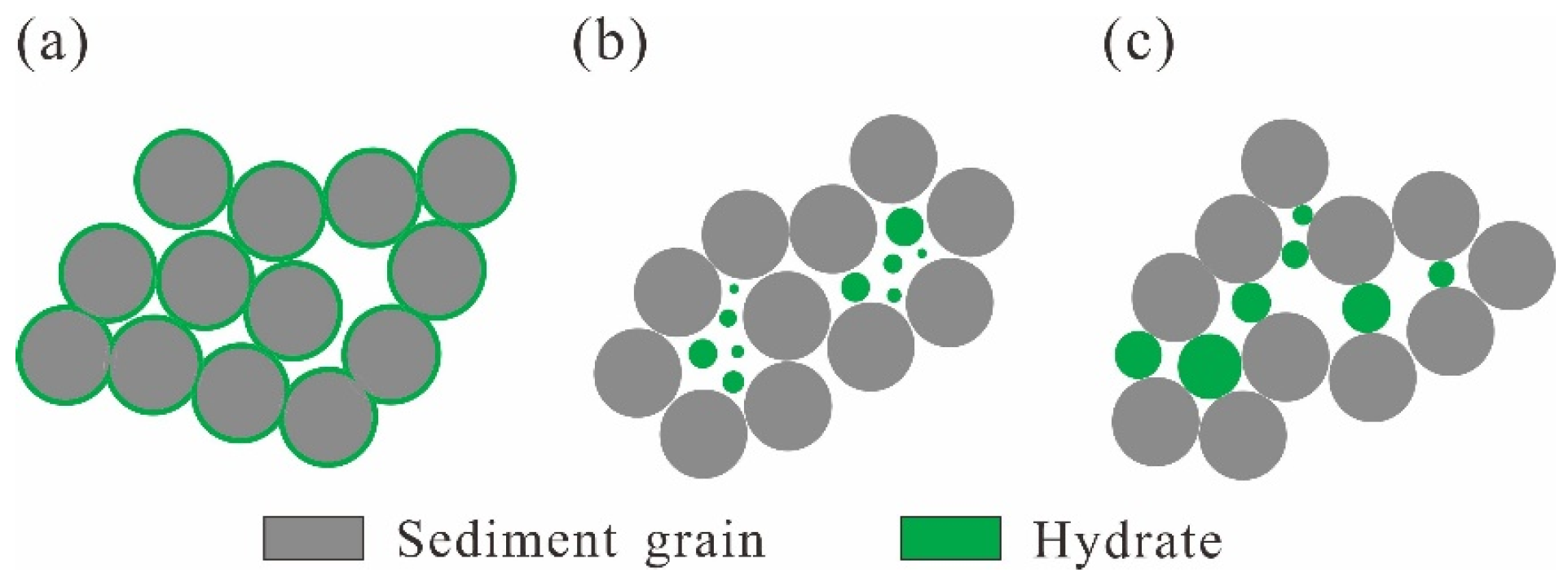
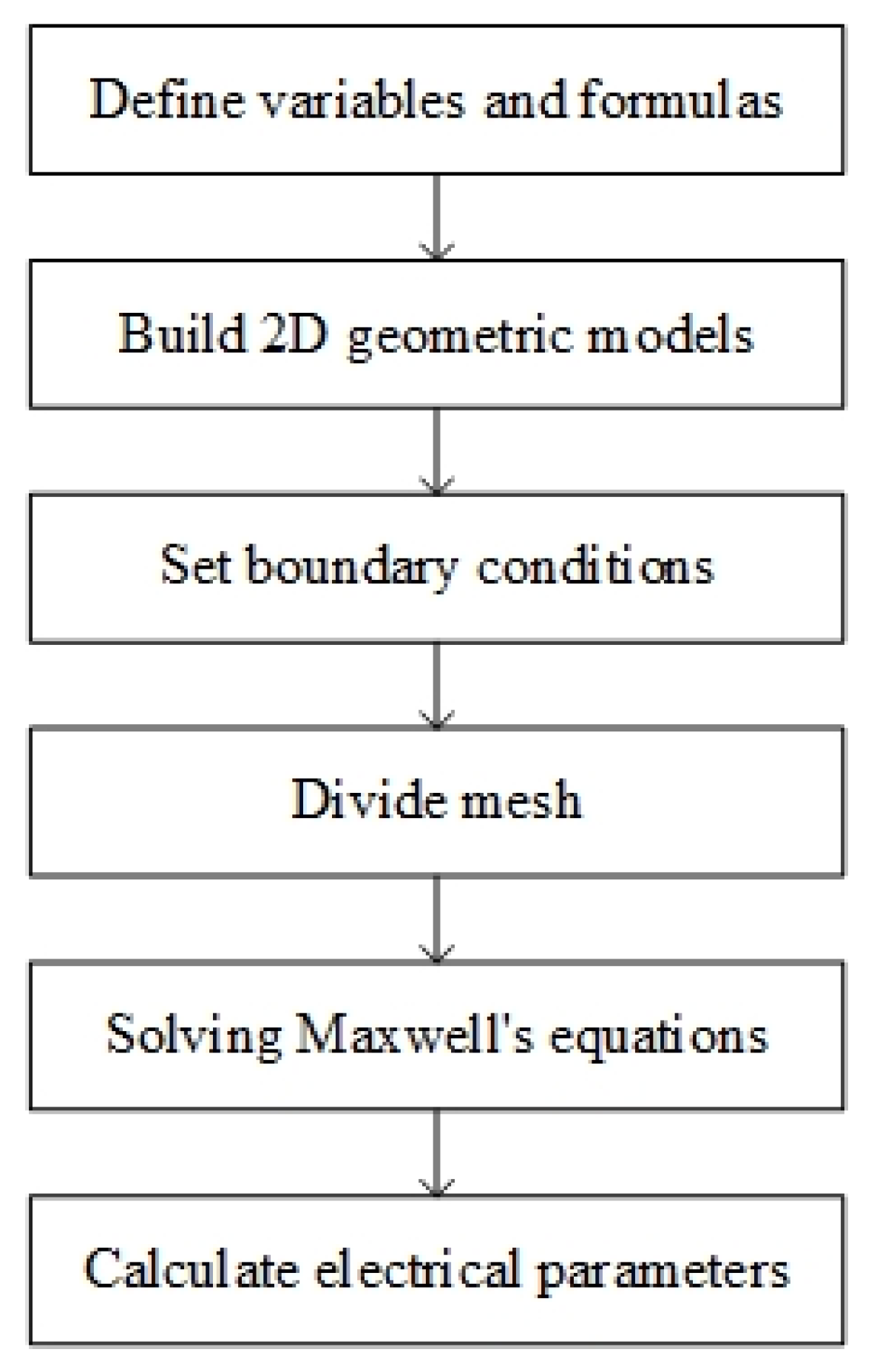
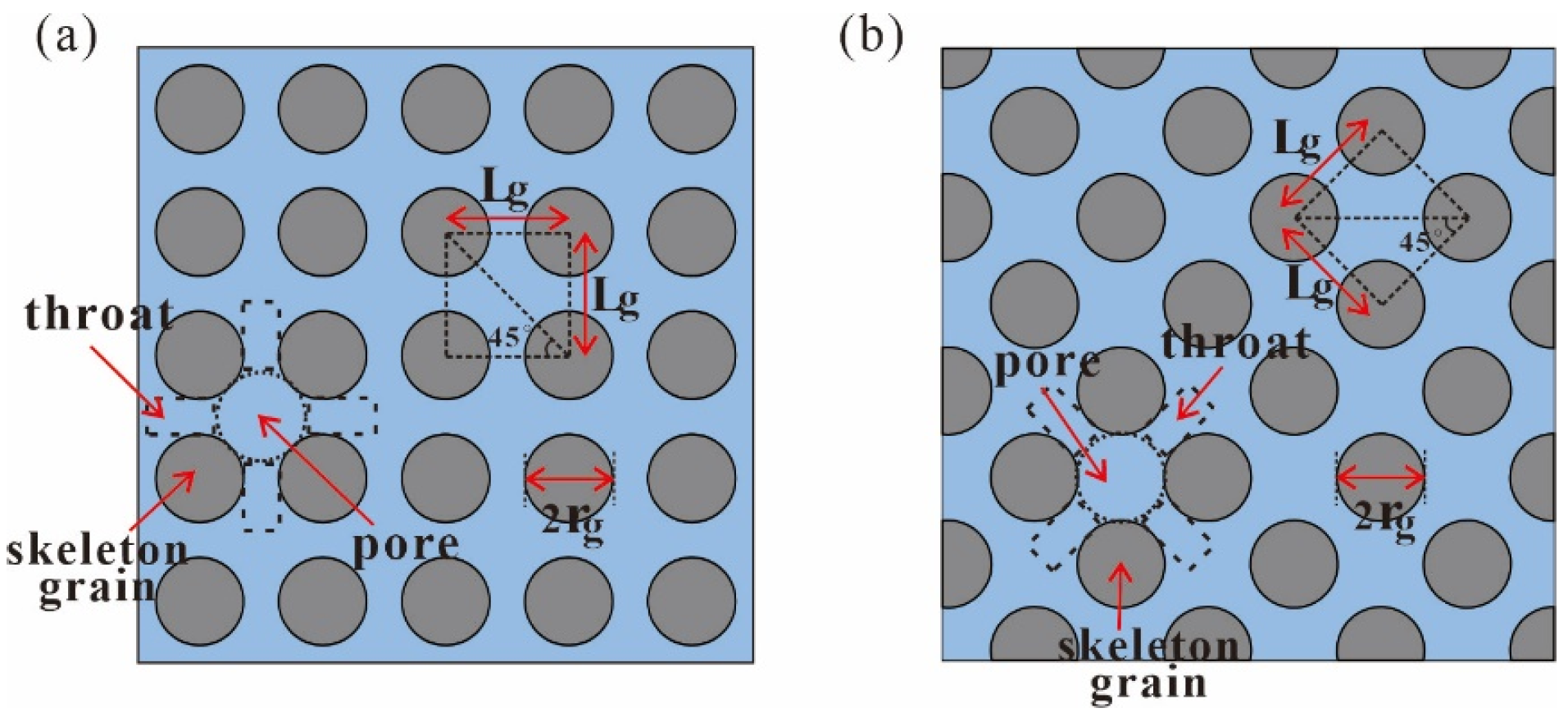


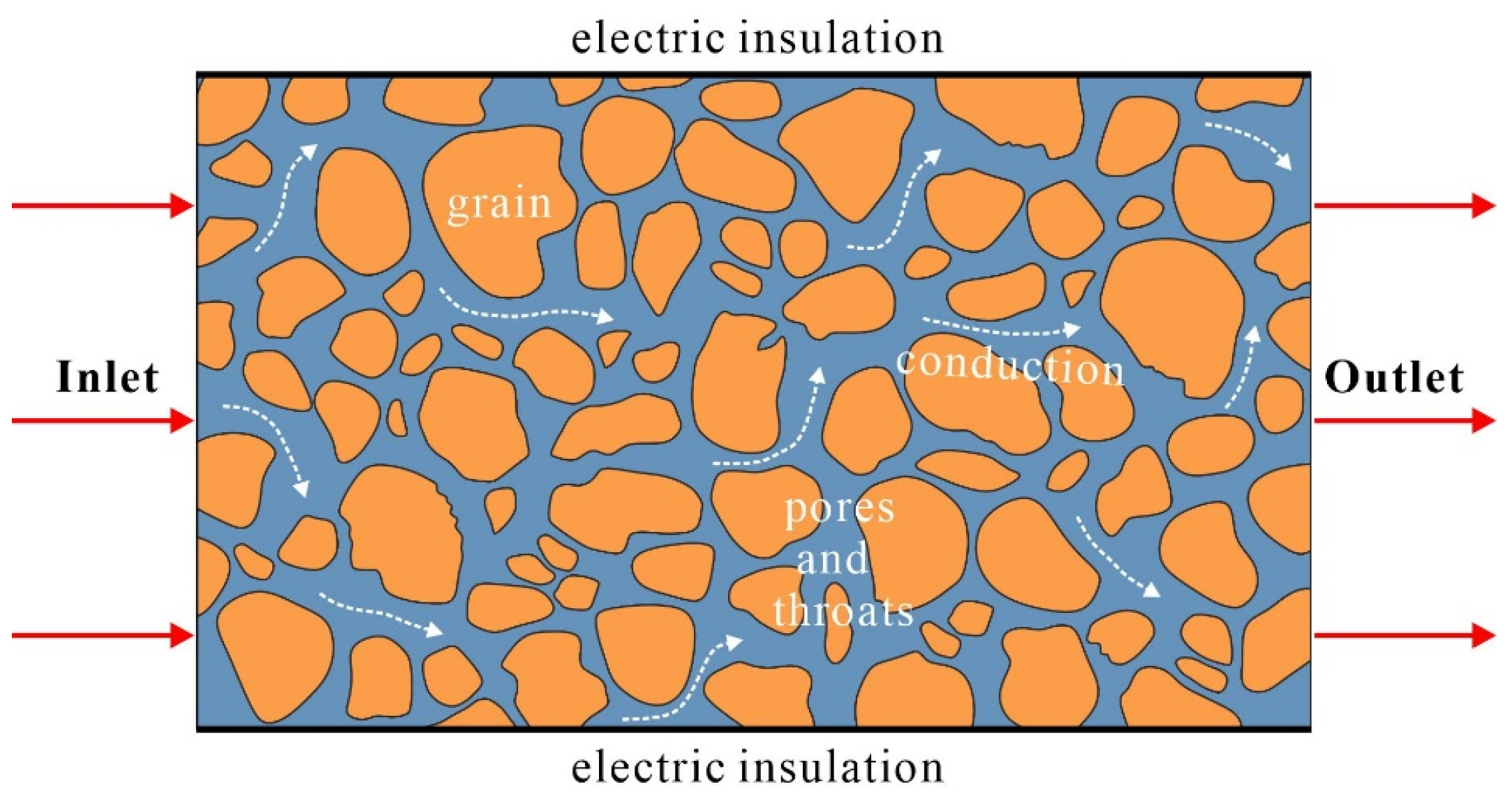

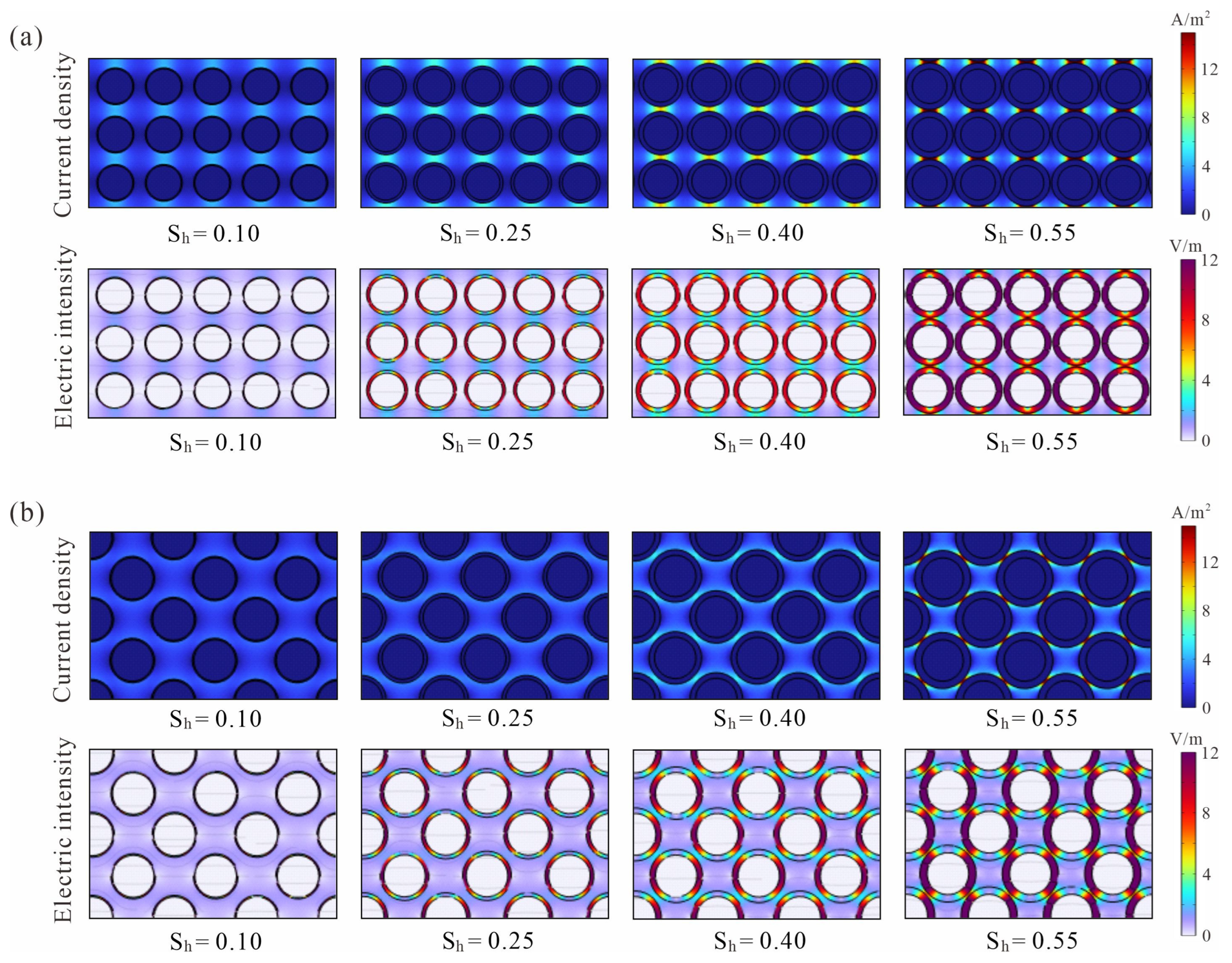
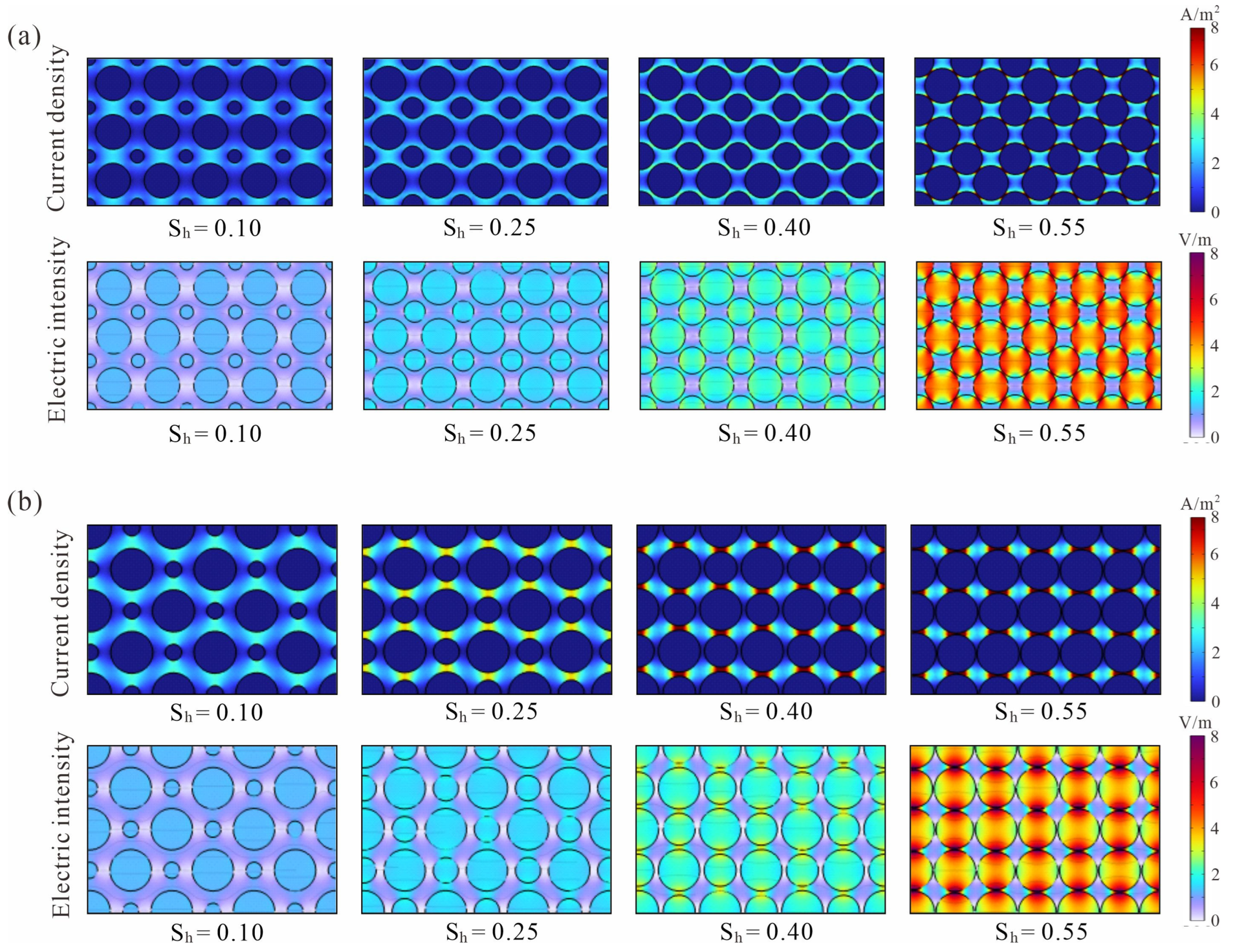
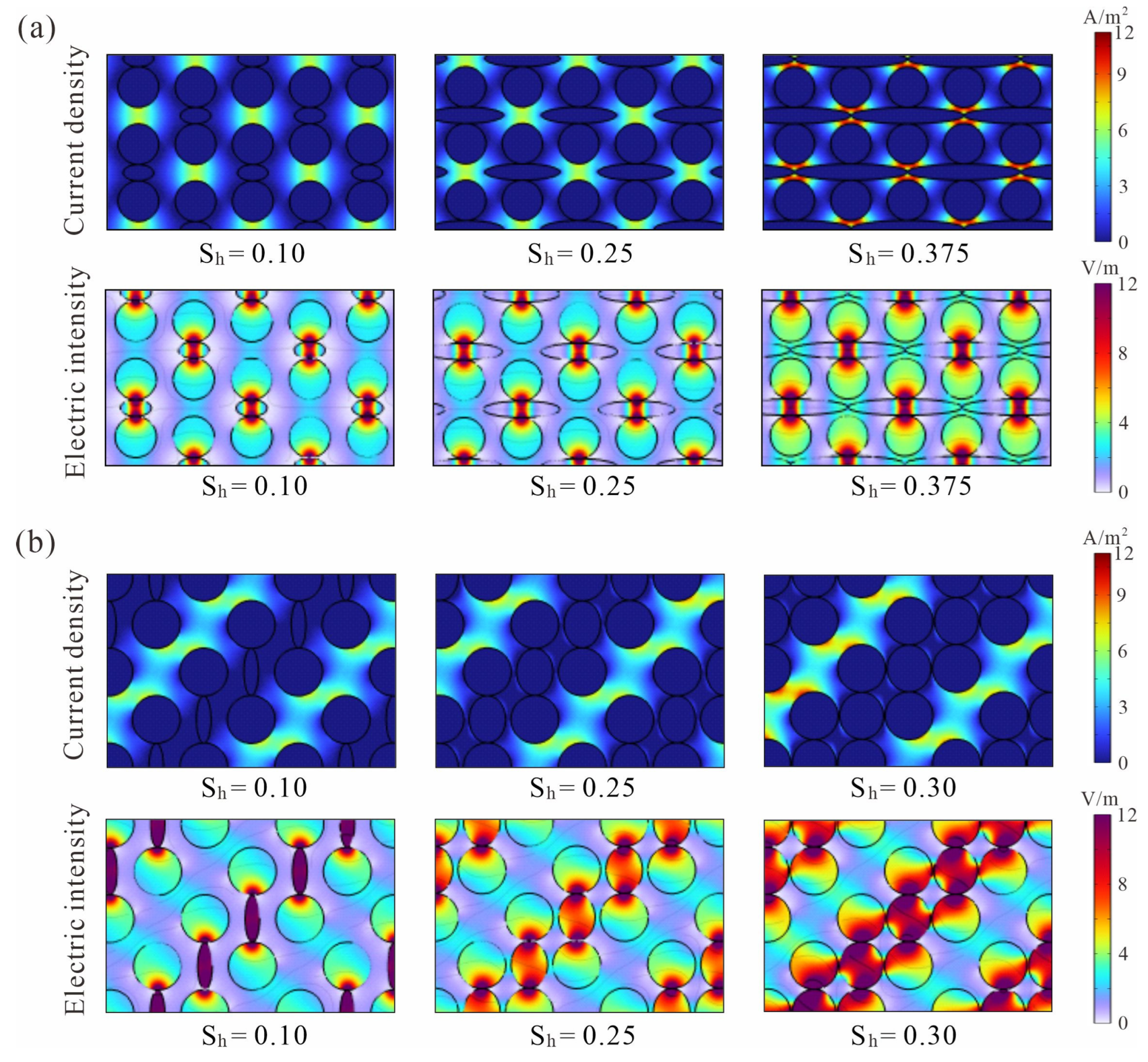
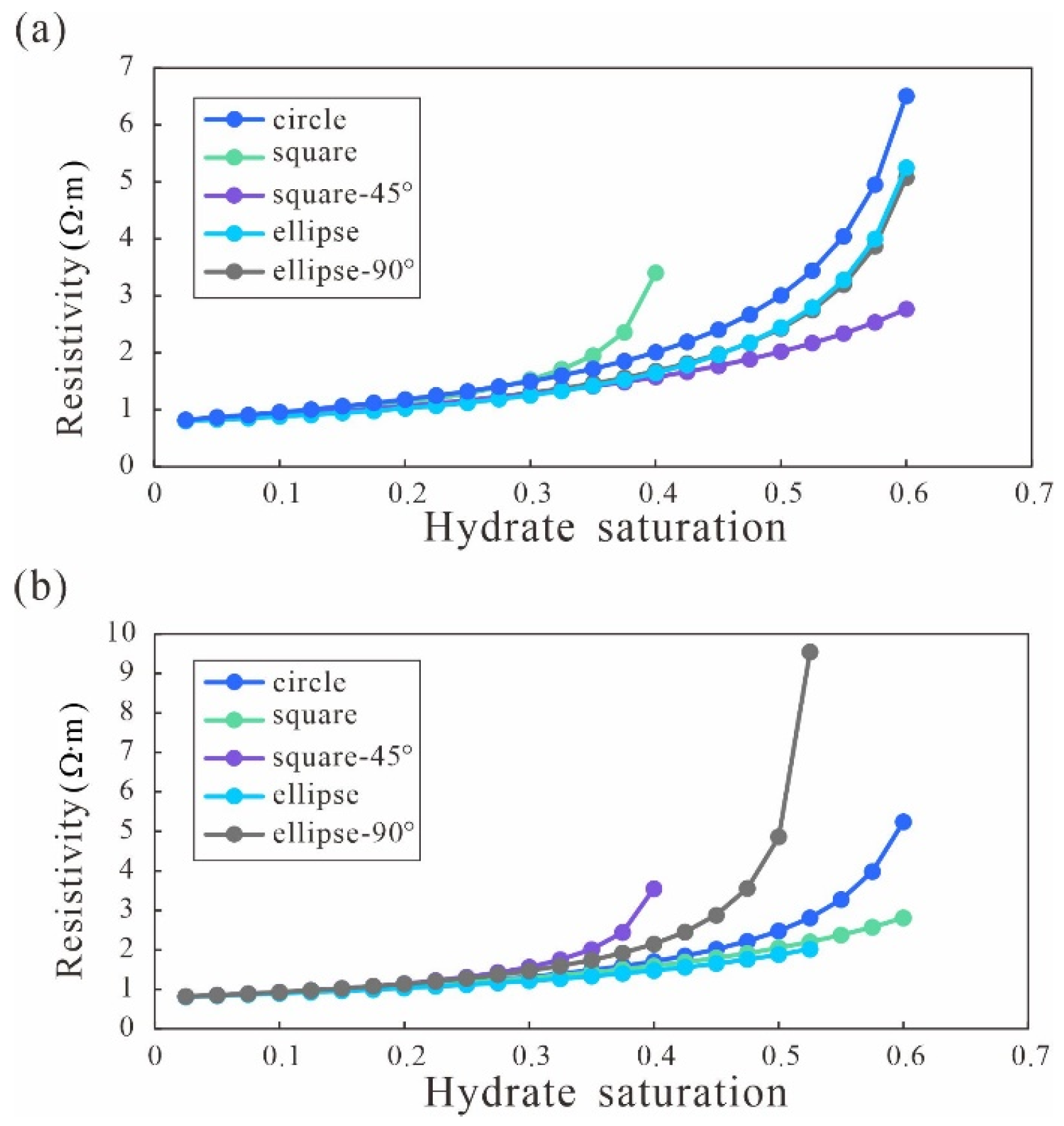
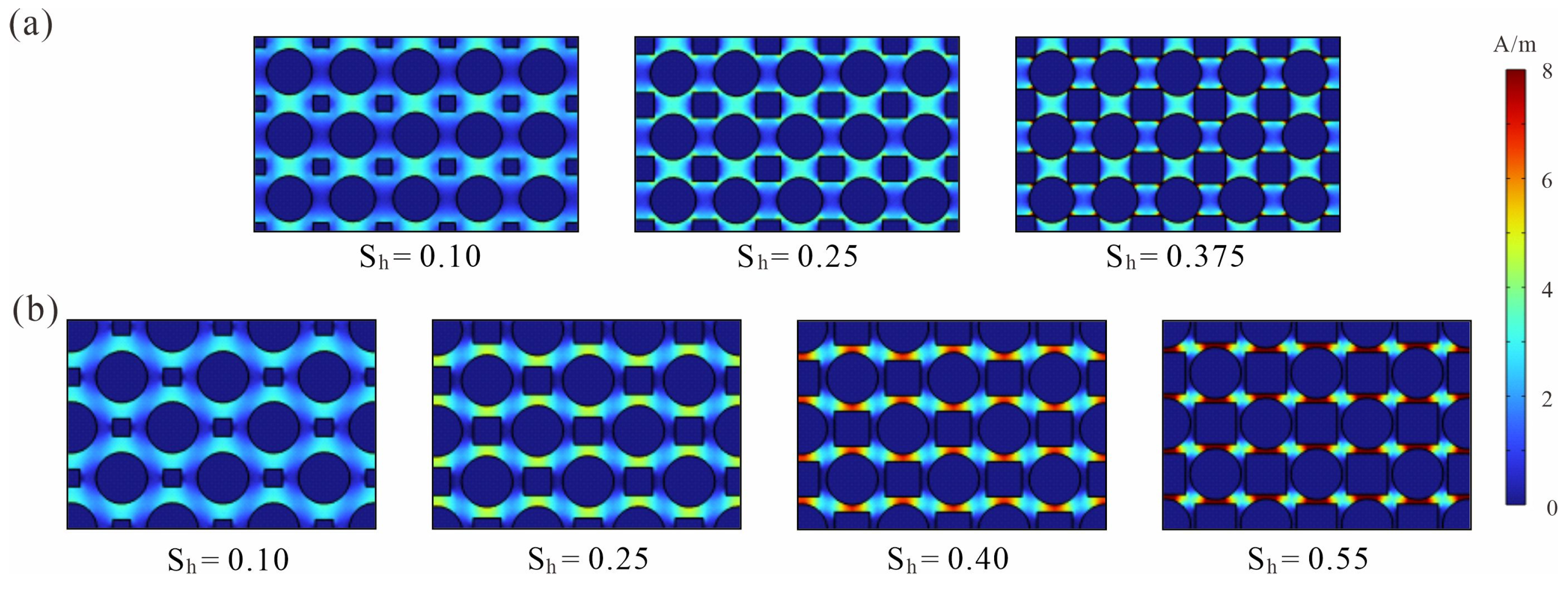



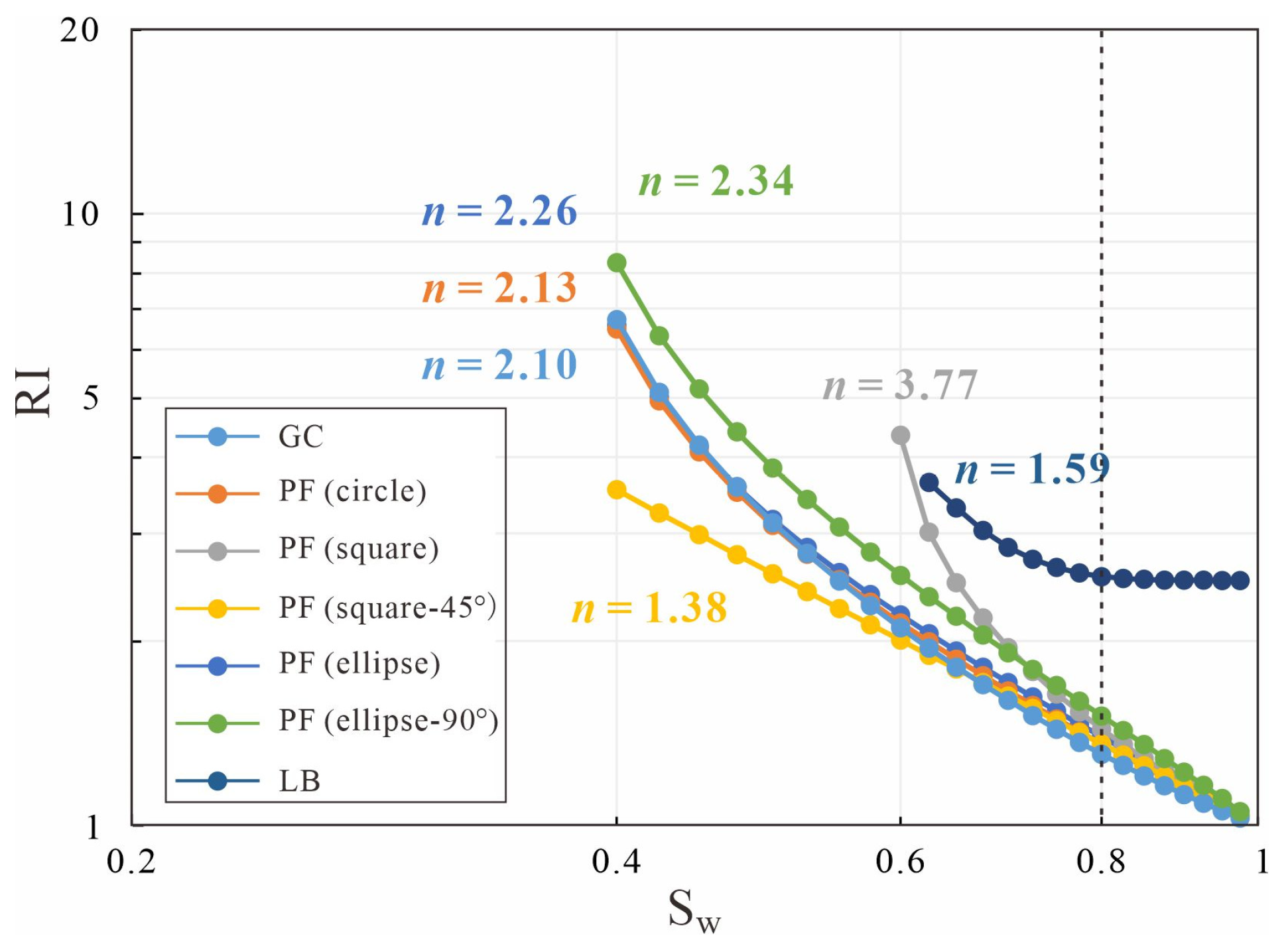
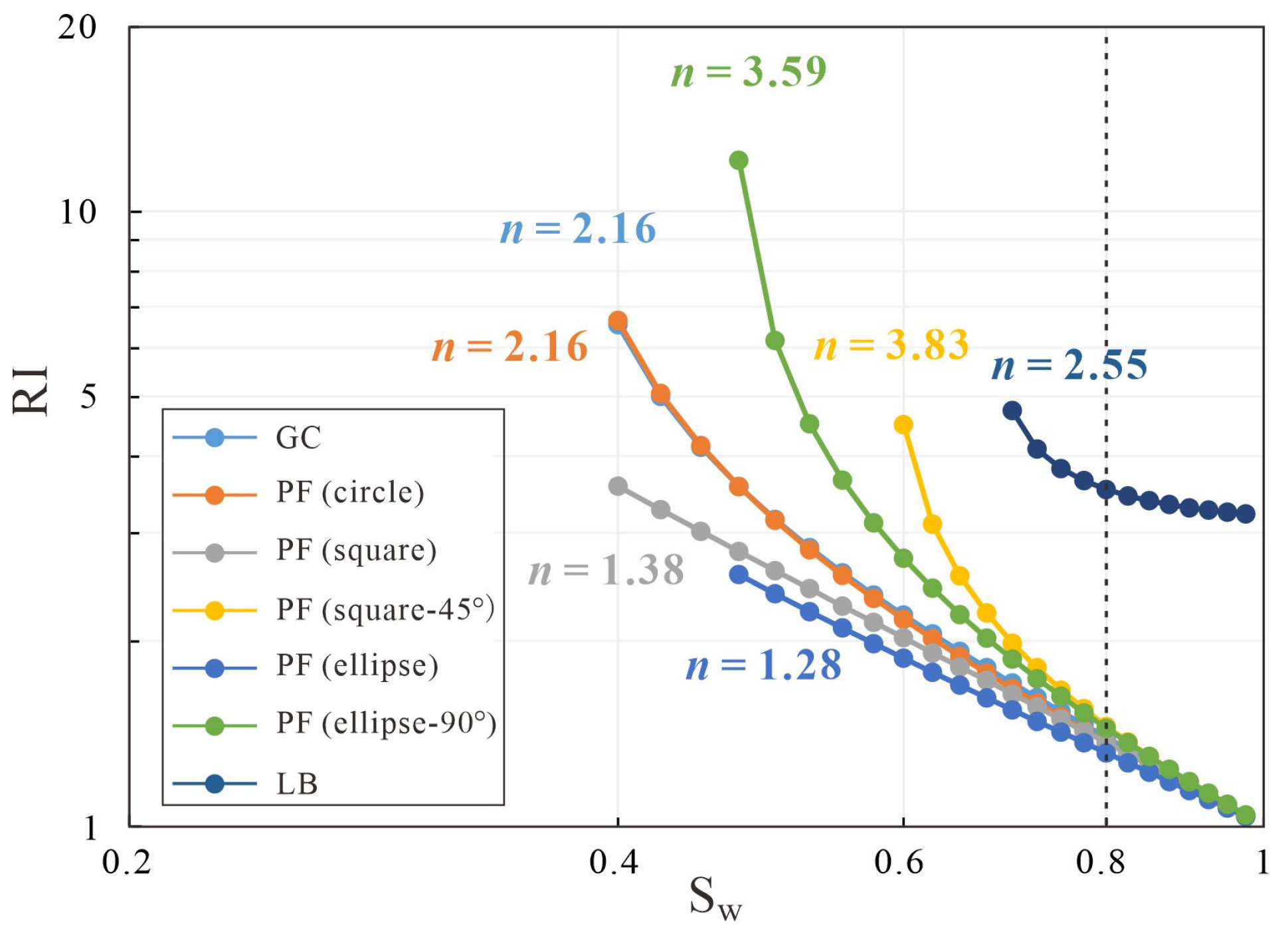

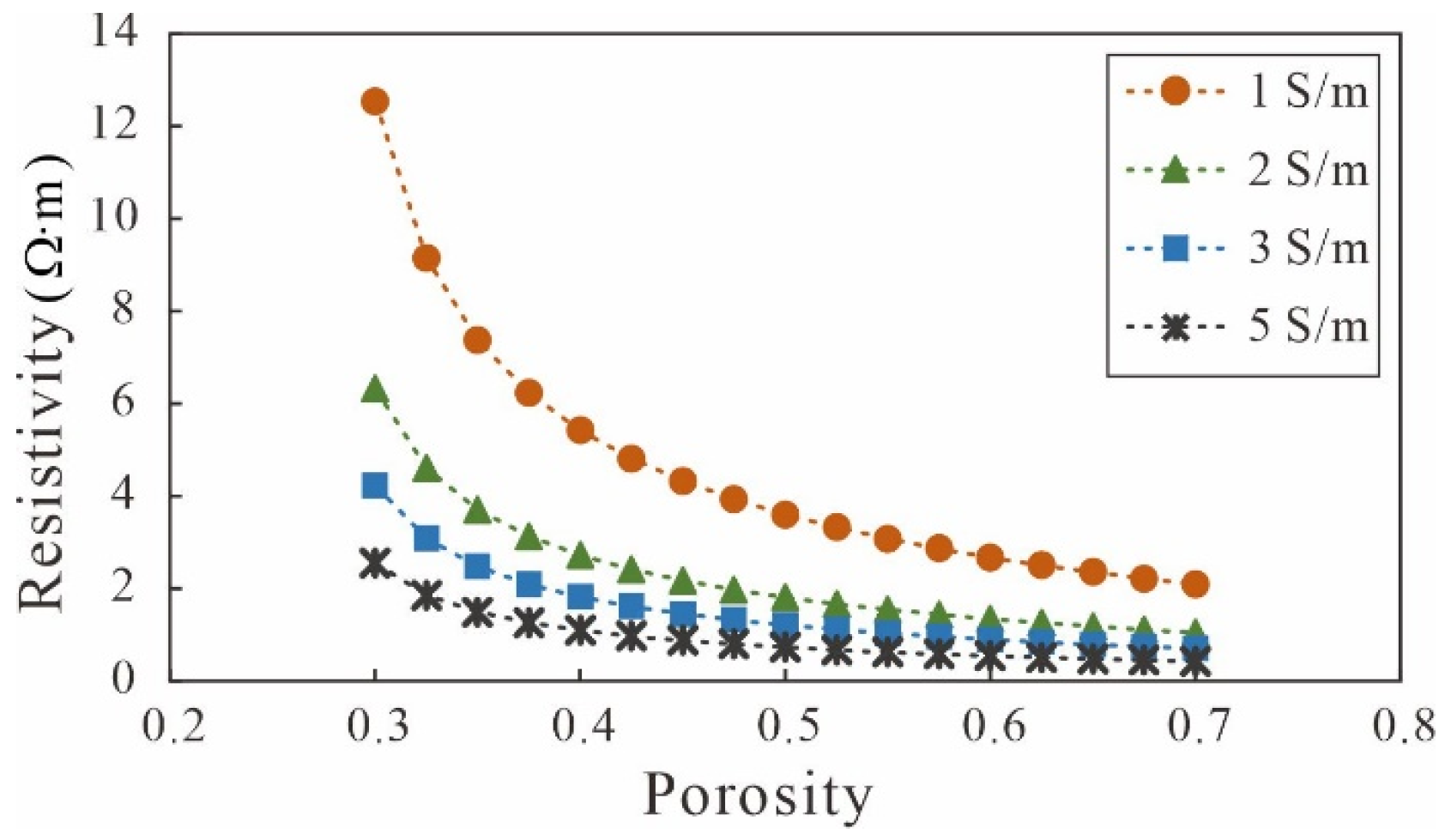
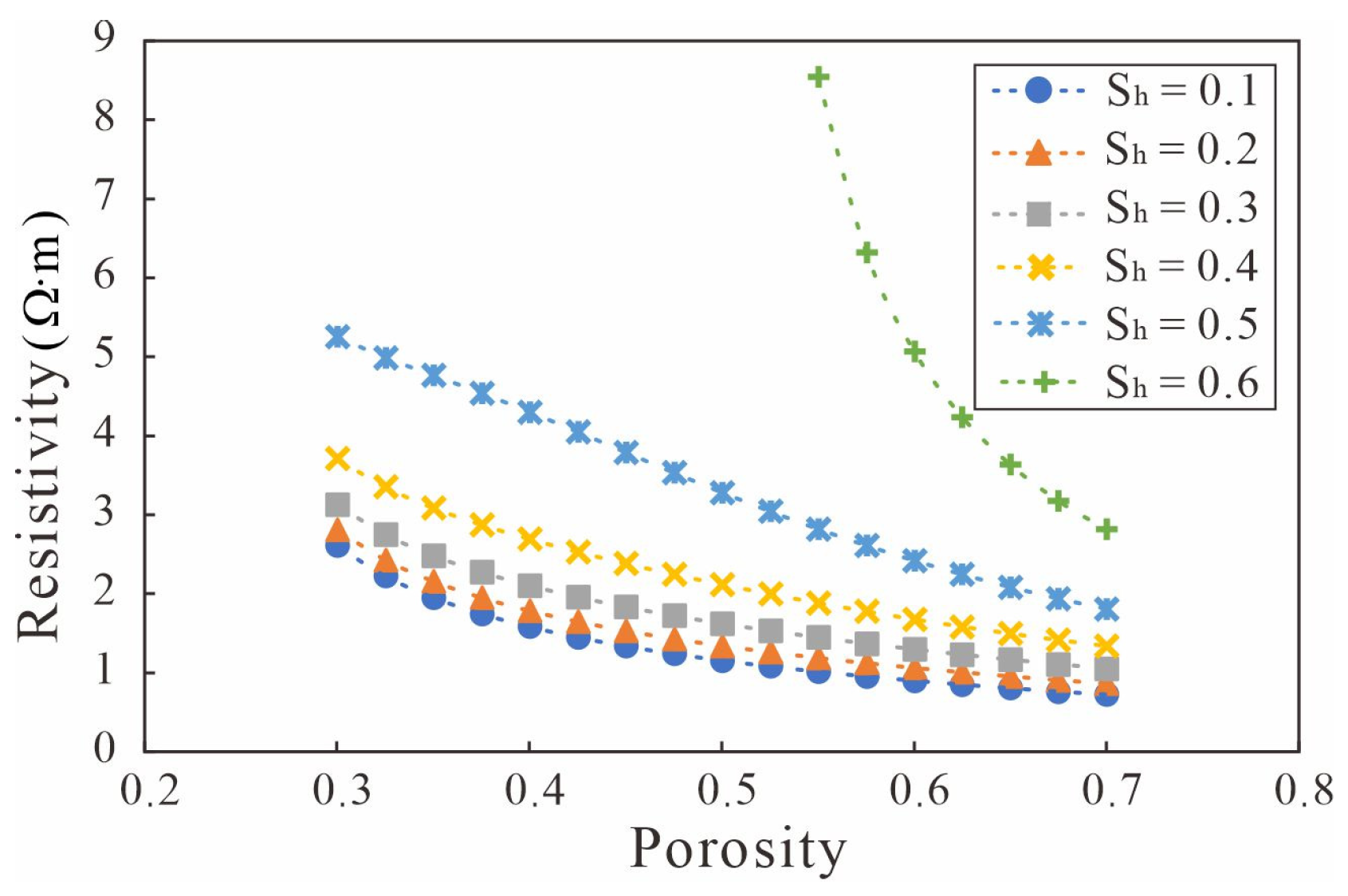
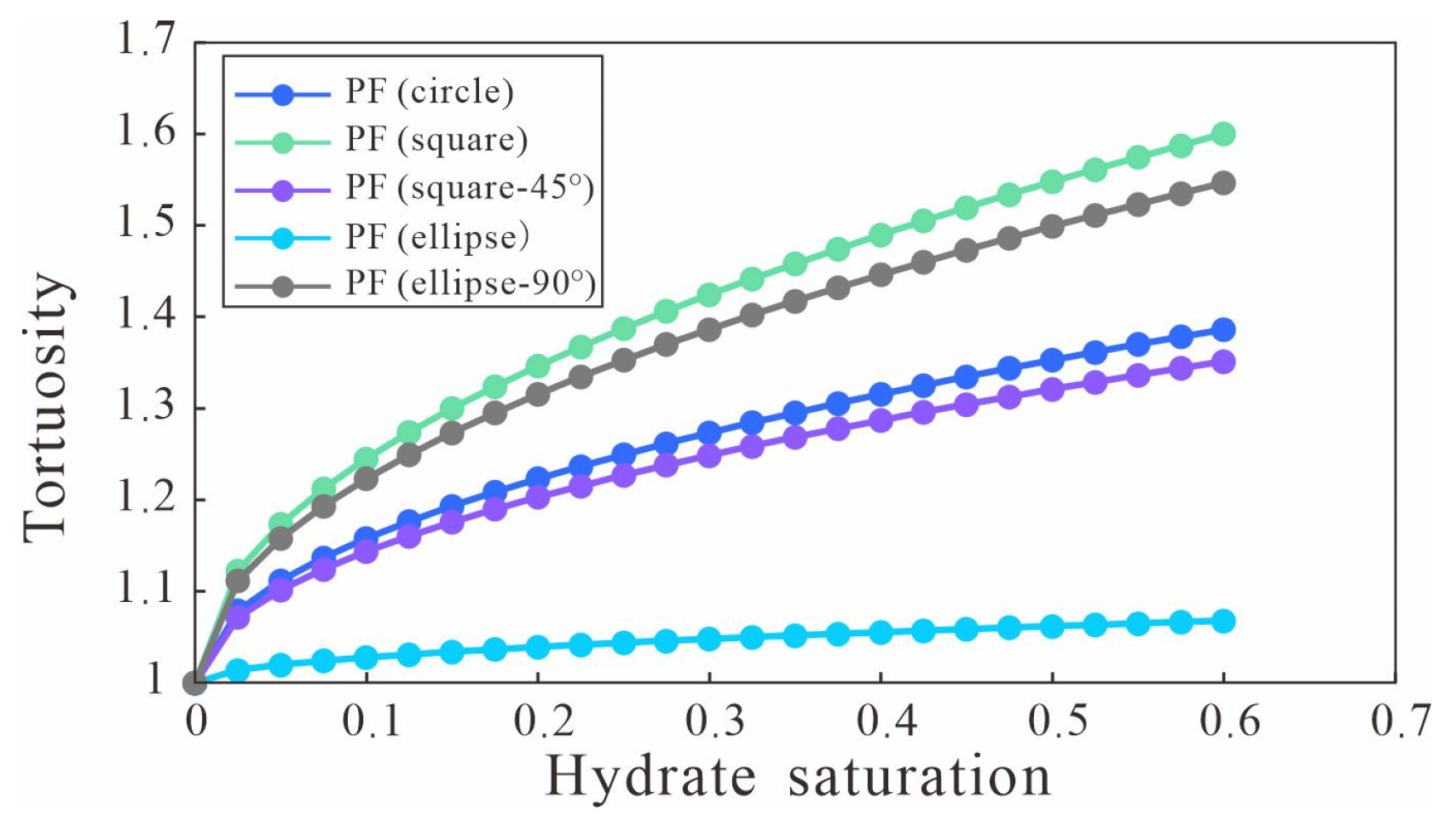
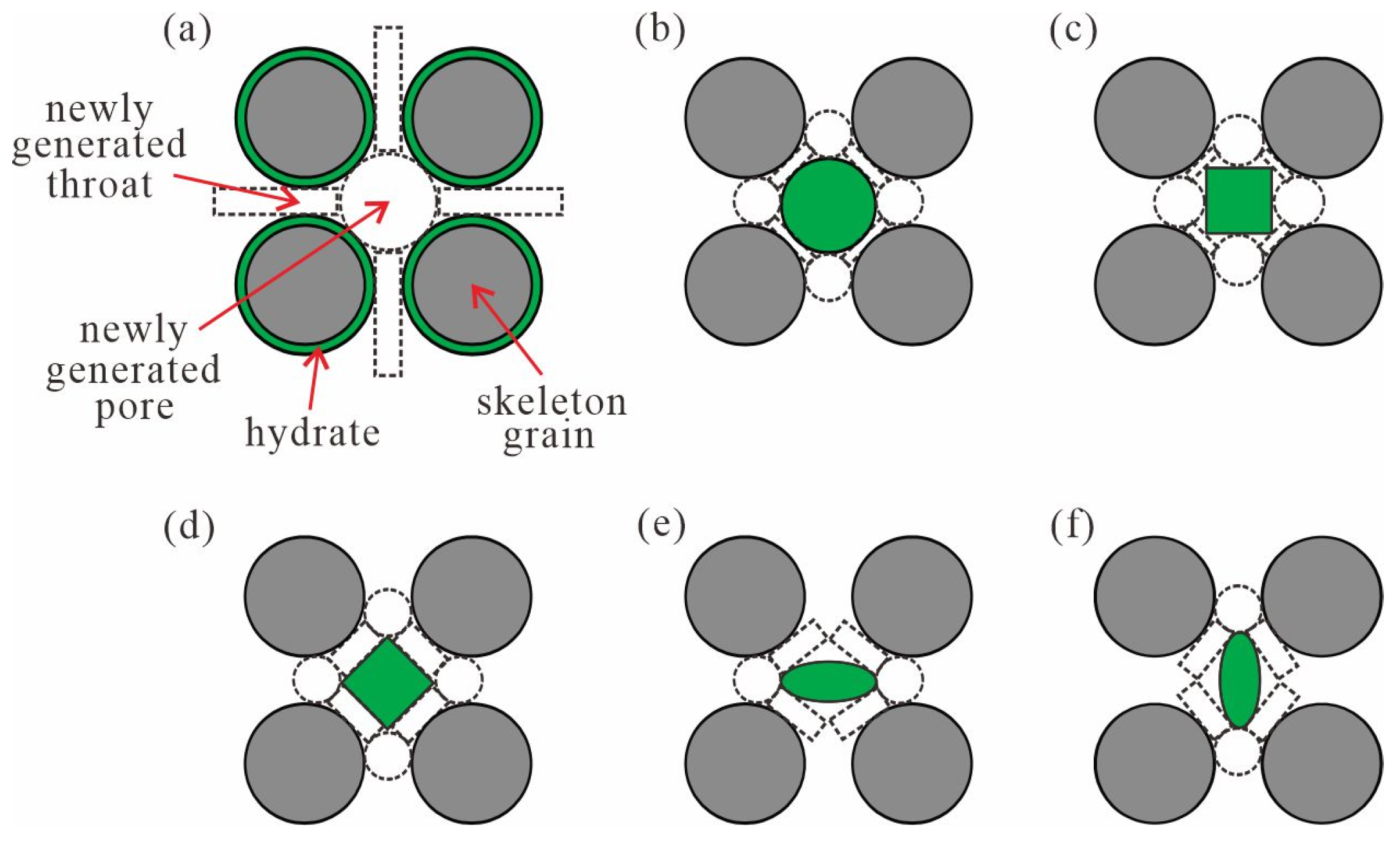
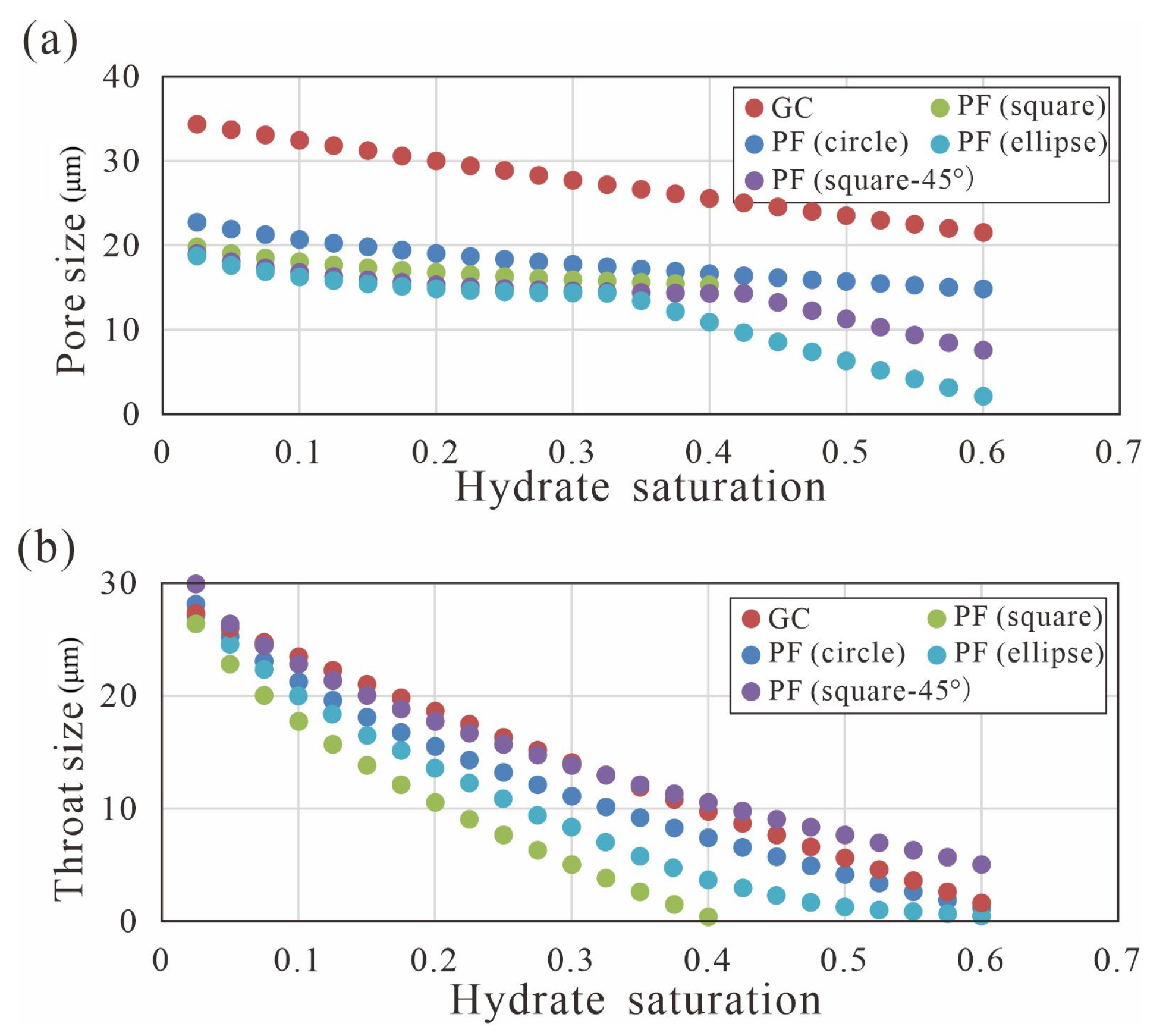
| Mode | GC | PF (Circle) | PF (Square) | PF (Square-45°) | PF (Ellipse) | PF (Ellipse-90°) | LB | Mean |
|---|---|---|---|---|---|---|---|---|
| Model A | 2.10 | 2.13 | 3.77 | 1.38 | 2.26 | 2.34 | 1.59 | 2.22 |
| Model B | 2.16 | 2.16 | 1.38 | 3.83 | 1.28 | 3.59 | 2.55 | 2.42 |
Disclaimer/Publisher’s Note: The statements, opinions and data contained in all publications are solely those of the individual author(s) and contributor(s) and not of MDPI and/or the editor(s). MDPI and/or the editor(s) disclaim responsibility for any injury to people or property resulting from any ideas, methods, instructions or products referred to in the content. |
© 2023 by the authors. Licensee MDPI, Basel, Switzerland. This article is an open access article distributed under the terms and conditions of the Creative Commons Attribution (CC BY) license (https://creativecommons.org/licenses/by/4.0/).
Share and Cite
Lan, X.; Zou, C.; Peng, C.; Wu, C.; Zhang, Y.; Wang, S. Numerical Simulation of Electrical Properties for Pore-Scale Hydrate-Bearing Sediments with Different Occurrence Patterns and Distribution Morphologies. J. Mar. Sci. Eng. 2023, 11, 1169. https://doi.org/10.3390/jmse11061169
Lan X, Zou C, Peng C, Wu C, Zhang Y, Wang S. Numerical Simulation of Electrical Properties for Pore-Scale Hydrate-Bearing Sediments with Different Occurrence Patterns and Distribution Morphologies. Journal of Marine Science and Engineering. 2023; 11(6):1169. https://doi.org/10.3390/jmse11061169
Chicago/Turabian StyleLan, Xixi, Changchun Zou, Cheng Peng, Caowei Wu, Yuanyuan Zhang, and Shengyi Wang. 2023. "Numerical Simulation of Electrical Properties for Pore-Scale Hydrate-Bearing Sediments with Different Occurrence Patterns and Distribution Morphologies" Journal of Marine Science and Engineering 11, no. 6: 1169. https://doi.org/10.3390/jmse11061169
APA StyleLan, X., Zou, C., Peng, C., Wu, C., Zhang, Y., & Wang, S. (2023). Numerical Simulation of Electrical Properties for Pore-Scale Hydrate-Bearing Sediments with Different Occurrence Patterns and Distribution Morphologies. Journal of Marine Science and Engineering, 11(6), 1169. https://doi.org/10.3390/jmse11061169






